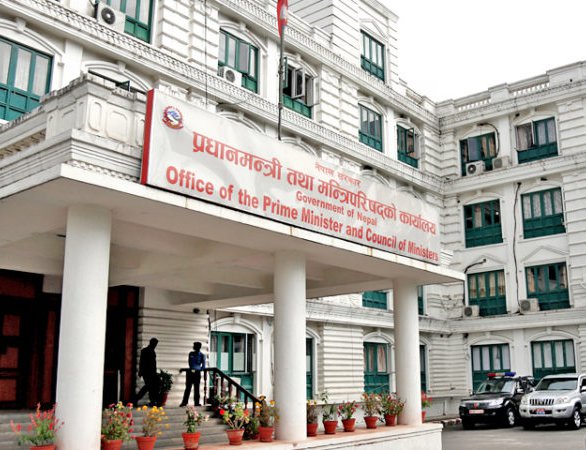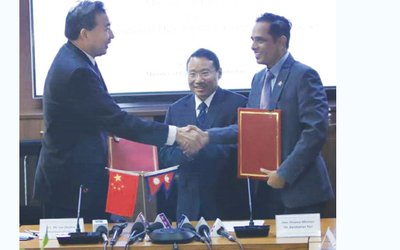
Rapid
degradation of natural environment has convinced the political leadership to
practice environmental governance through a dedicated ministry by renaming the
Ministry of Forests and Soil Conservation (MoFSC) to the Ministry of Forests
and Environment (MoFE) in 1991. This was the expression of the positive
initiatives of the Environmental Impact Study Project, established in 1982
under the MoFSC. Immediately after the establishment of the MoFE, a group of
people lobbied that 'a soldier that loses the battle has been again sent to fight
the next one: how could he win it?' At that time, it was understood that
Nepal's environmental problems are more related to deforestation, forest
degradation, soil erosion, landslides and floods, and MoFSC had not been
effective in conserving forests, biodiversity, soil and watersheds but it had
been given additional mandate for environmental management. This inclusion of
the environment in forestry sector did not work well. Environmental matters did
not cross the forest boundary as MoFSC was foresters-dominated institution. It did
not show its competency which may be due to 'sector syndrome' in discharging
environmental functions outside the forest area. The MoFE conducted a study to
propose institutional structure for the environment. The study proposed to
establish Environment Protection Council (EPC) as a coordinating entity. The
Government established the Council in 1993, as an advisory body, under the
chair of the Prime Minister with its Secretariat in the National Planning
Commission, another advisory body. Establishment of the EPC changed the
environmental governance from a regulatory ministry to an advisory status.
Environmental challenges heightened and the Government established the Ministry of Population and Environment (MoPE) in September 1995, likely to merge with another Ministry in near future after 22 years. It faced frequent merger and separation with science and technology between 2005 and 2015 without any notable changes in institutional mandate and structure. Now, it is named as MoPE, going back to the concept of 1995. The Government established the Department of Environment as its 'technical arm' after 15 years of functioning of the Ministry.
During the last 45 years, the Government has made several commitments at the international level in addressing environmental challenges without prioritising environment management 'for action' at the national and local levels. Sometimes, environment is considered as a 'burden'. During the last 22 years, the environment ministry enjoyed with 'very new political leadership' and few of them were instrumental in advancing environmental governance. Few secretaries proved themselves as a 'change agent' by taking new initiatives, expediting to achieve 'something', building capacity and/or bringing resources for domestic action.
Although the environmental ministry has multi-faceted responsibilities and working areas, it has yet to prove its 'existence' by providing 'professional leadership' and institutional response. For example, air pollution in the Kathmandu Valley was realised in early 1970s and Nepal's national report to the UN Conference on 'Human Environment' in 1972 committed to take actions to reduce pollution. After four and half-decades, the Secretary at the Prime Minister's Office is organising series of meetings to reduce 'barriers' in improving air quality in the Valley. However, MoPE has also mandate for 'coordination'.
Although MoPE could not deliver and guide in providing 'hygienic environmental quality' to Nepali people, and people living in the Kathmandu Valley, it has established systems for addressing environmental challenges through, inter alia, environmental impact assessment (EIA), environmental quality standards and/or international negotiation. Almost all countries have practiced EIA as a 'proven tool' in managing environmental resources. Although EIA has been mis-understood or mis-interpreted or mis-guided by many politicians, bureaucrats, project developers, investors and 'consultants' in Nepal, it has been legally grounded in national environmental governance system. Unfortunately, Nepal has yet to enjoy the benefits of EIA at operational level. Nepal's policy and legal regime on EIA is 'proactive and user-friendly'. Several guidelines are in place to prepare project-specific, practical and easy-to-implement EIA report.
Nepal has issued generic and source-based effluent and air quality standards, including ambient standards. Similarly, Nepal has been engaged in negotiation of environment-related Conventions, Treaties, Protocols and Agreements in general and climate change regime in particular. Nepal has proved its competency in climate change negotiation to represent/lead 48 LDCs being the chair of the LDC coordination group for two years (2013 and 2014). Public awareness has heightened. However, implementation of existing instruments is 'grossly' poor.
Nepal has recently started documentation and sharing of environmental practices. In many cases, it is necessary to contact an individual engaged in discharging specific functions as institutional memory is low. Frequent changes in institutions and transfers of officials have also caused the loss of memory, the concept and foundation of positive actions. So 'building on foundation' does not properly work in Nepal but opportunities are used for situation-based interpretations. This situation will continue and might be even grave in the new governance structure. It is most likely that nearly two and half-decades of institutional memory on the environment will be in peril due to merging of the environment with a ministry having 'homogenous human resources' and Nepal might again be back to the stage of early 1990s on environmental governance. It will likely result in a challenge in meeting national and international obligations and commitments on the environment.

Batu Uprety
Former Joint-Secretary and Chief of Climate Change Management Division, Ministry of Environment (then), and former Team Leader, National Adaptation Plan (NAP) formulation process. E-mail: upretybk@gmail.com
- Dialogue On Mountains And Climate Change Planned
- Apr 19, 2024
- Institutional Response And Leadership on Climate Negotiations
- Mar 28, 2024
- The Wire Without A Current
- Mar 20, 2024
- Call For Degazetting the Shivapuri-Nagarjun National Park
- Feb 08, 2024
- Advancing Need-Based Adaptation Options
- Jan 14, 2024
















